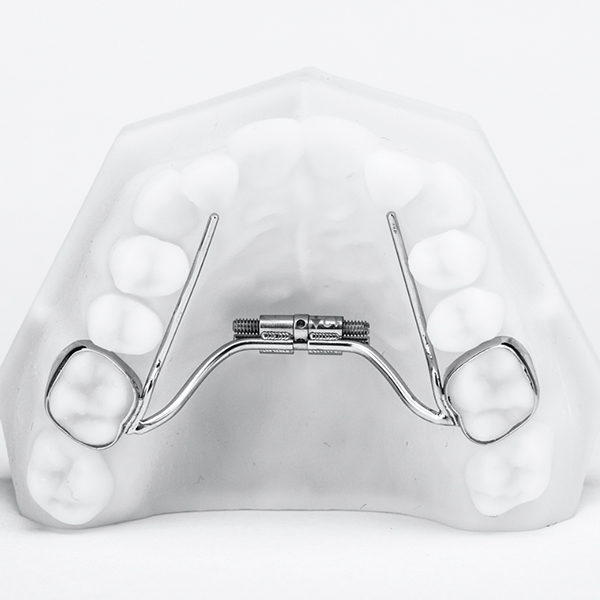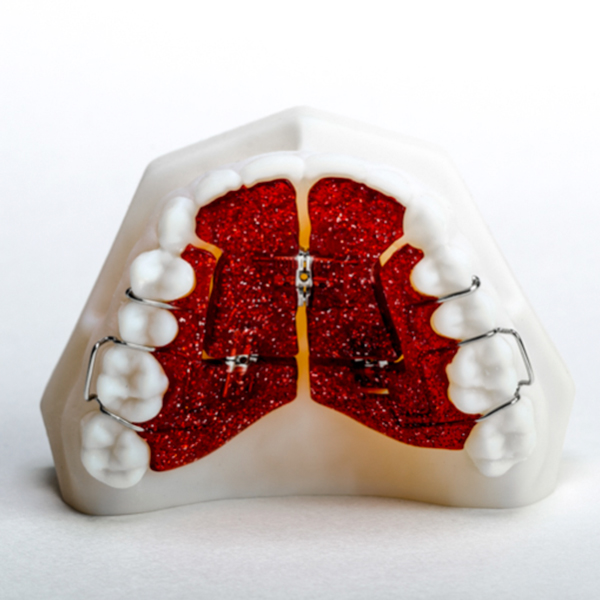

Palatal Expanders
Early treatment options for young Staten Islanders
Palatal Expanders for Kids
Palatal expanders may sound scary, but they’re a totally cool (and comfortable) way to prevent big problems in little smiles. A common treatment for children, palatal expanders work over several months to gradually widen the upper jaw. At 103 Orthodontics, we use palatal expanders to solve breathing issues, crowding, crossbites, and even impacted teeth at a young age.
Palatal Expander Frequently Asked Questions
What is a Palatal Expander?
A palatal expander is an orthodontic appliance used to widen the upper jaw. Expanders are most common at a young age – before 10 years old – when the upper jaw is most malleable and pliable. At this young age, an expander is extremely successful, predictable and efficient. There are various different designs of palatal expanders, but the goal is always the same – to expand the upper jaw bone to the appropriate width.
How does a Palatal Expander work?
In order to understand the mechanics behind a palatal expander, you first need to know that the upper jaw actually consists of two bones: a right bone and a left bone. These two bones meet right down the middle, starting between your two upper front teeth and extending all the way to the back. As we age, these two bones slowly solidify and fuse together into essentially one bone. However, when we are young, the fusion between the right bone and left bone is minimal, if existent at all. Thus, these two bones can be easily separated when young, and this is the function of an expander. A palatal expander applies pressure to separate these two bones of the upper jaw. We can’t see this happening by just looking in the mouth – it happens above the gum tissue. Then, new bone actually grows between the two separated bones. As a result, we are actually able to create a physically wider upper jaw. Pretty cool! Imagine if this technology could be used to make us taller? It sort of can, but that’s a question for an orthopedic surgeon.
Why would a child need a Palatal Expander?
First of all, not everyone needs a palatal expander. In our Staten Island office, palatal expanders are needed in specific situations but only when absolutely necessary. The function of a palate expander is simple – to widen a constricted upper arch. But what causes a constricted upper arch that would need expansion?
- A. The most common cause of a constricted upper arch is an extended pacifier or thumb sucking habit. The sucking action puts pressure on the sides of the upper arch to come closer to each other, causing the upper arch to constrict and collapse inwards. Over time, this results in a narrow upper jaw.
- B. Another very common cause, although often undiagnosed, is a tongue-tie. When the tongue is tied to the floor of the mouth, the tongue’s movement is restricted, and the tongue is basically prevented from sitting at the roof of the mouth, meaning the tongue is not able to apply the appropriate pressure needed to widen out the upper arch. As a result, the upper arch ends up being too narrow over time.
- C. An extremely common cause of a constricted upper arch is genetics. If mom and/or dad needed an expander as a child, there is a decent likelihood that a child will need an expander, as a child may inherit a smaller shaped upper jaw.
- D. Believe it or not, but diet can actually affect the shape of the upper jaw. If you were to look at fossils of the upper jaw structure of cavemen, you would see an extremely broad shaped arch with straight teeth and adequate space for the wisdom teeth. The reason why cavemen had extremely wide jaw bones is due to their eating habits – lots of raw and difficult to chew foods. A recent long article about Orthotropics in the New York Times goes into detail on this concept and emphasizes the idea that diet can influence jaw structure. Extended reliance on soft, processed food may result in narrower arches and more future crowding of adult teeth.
Why is a Palatal Expander important?
When the upper arch is constricted, there are typically not only dental ramifications but also systemic issues. Your upper jaw bone is also the floor of your nasal cavity (the area behind your nose). So, if your upper jaw bone is narrow, your nasal cavity is typically also narrow. If your nasal cavity is narrow, you tend to have more nasal congestion, which tends to lead to more allergies, sinus infections and breathing issues.
Everybody breathes partially through the mouth and partially through the nose. The more you breathe through your nose, the better. Unfortunately, patients that have a narrow upper jaw also have a constricted nasal cavity, making breathing through the nose more challenging. So, most patients that have a constricted upper arch tend to also be mouth breathers, which leads to more snoring, which leads to more restless sleep, which leads to drowsiness during the day, making attentiveness in school or work more challenging.
To understand this even further, research has clearly shown that palatal expansion actually reduces bed wetting. At first, people are often surprised to hear this correlation. However, the connection is clear and makes complete sense when looking at the bigger picture. If a child has a constricted upper arch, then the nasal cavity is constricted, then breathing is mainly through the mouth, so snoring is more likely, sleeping is more restless, and inadequate sleep leads to more bed wetting. Palatal expansion not only widens the upper arch but also expands the nasal cavity, making nasal breathing easier, reducing snoring, giving a better night sleep, reducing the risk of bed wetting, decreasing drowsiness during the day, and increasing attention in school.
Also, from the orthodontic perspective, expanding the upper arch creates a lot more room for adult teeth to come into the mouth properly. If there are upper canines or other upper adult teeth that are coming into the mouth in a poor direction due to inadequate space, an orthodontist is most likely going to recommend palatal expansion at a young age, typically before middle school.
Let’s Party
From grins to ROFL’s, we welcome anyone to come and enjoy the path to a better smile with us.



